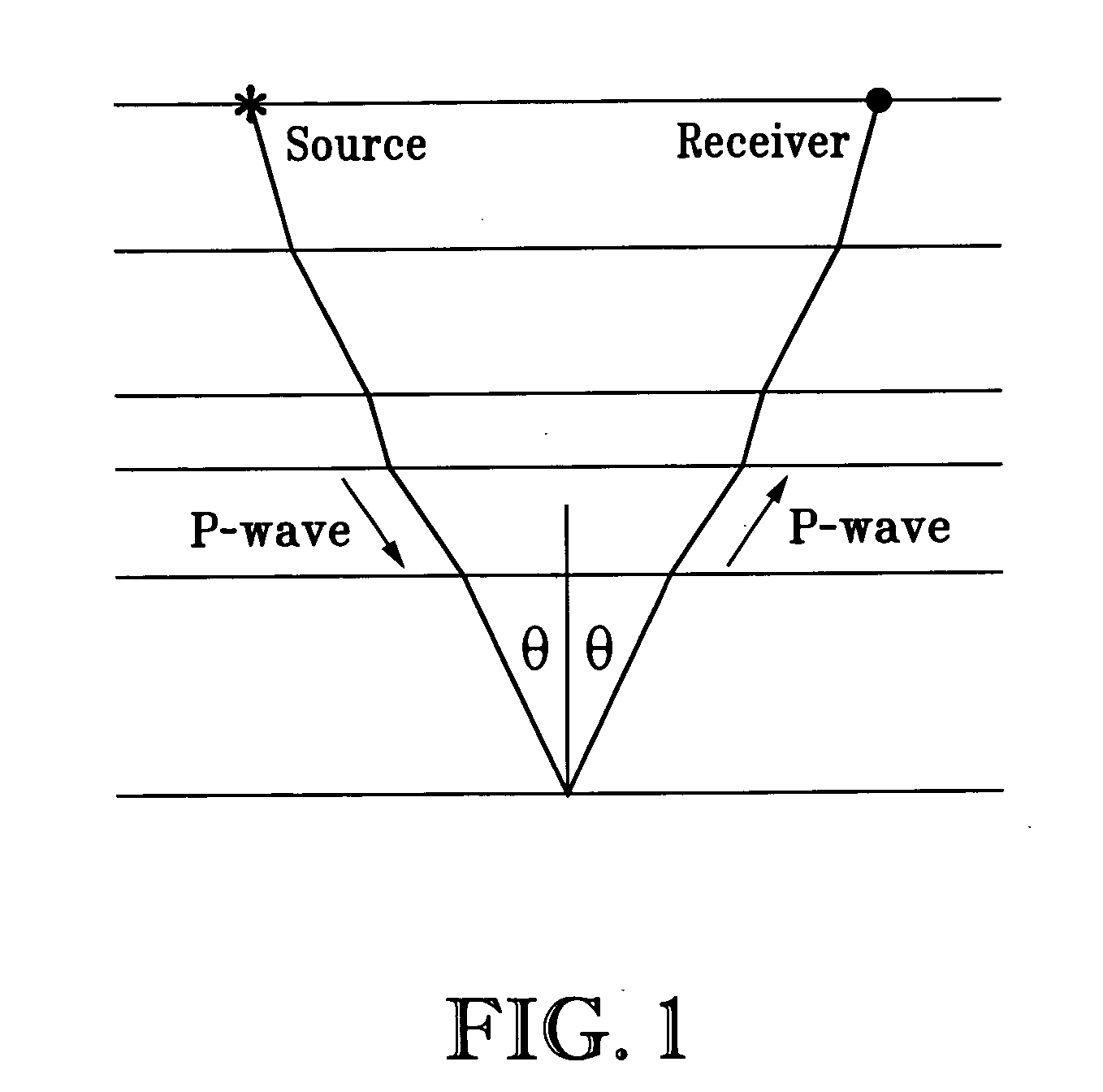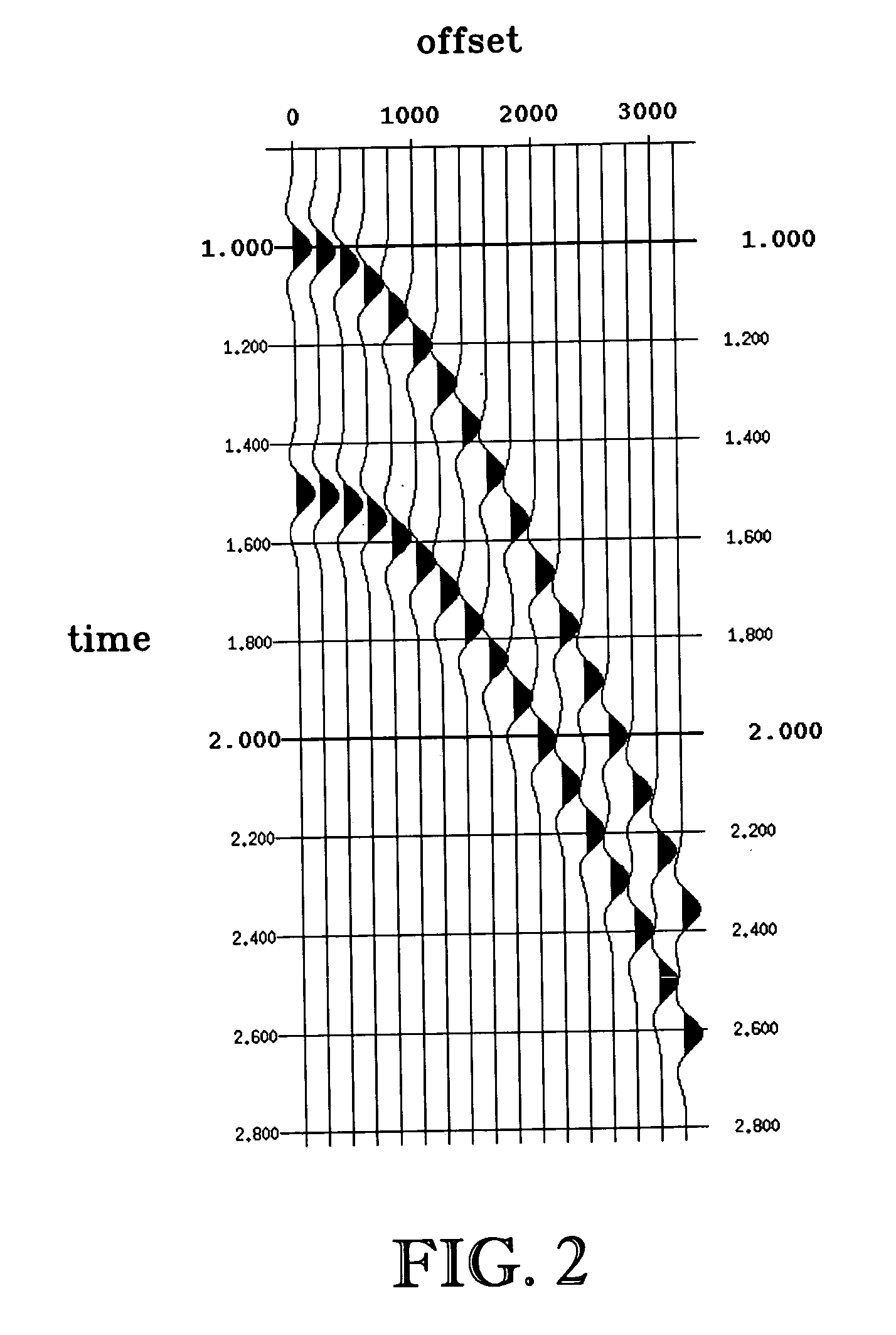Method of accounting for wavelet stretch in seismic data
a seismic data and angle-dependent technology, applied in seismic surveys, instruments, measurement devices, etc., can solve the problems of energy bleeding, unfavorable loss of high frequency data at far offset, traces and wavelets resulting from conventional seismic survey approaches are often subject to shifting, etc., to achieve easy calculation and easy implementation of angle-dependent wavelet stretch, the effect of easy accounting for angle-dependent wavelet stretch
- Summary
- Abstract
- Description
- Claims
- Application Information
AI Technical Summary
Benefits of technology
Problems solved by technology
Method used
Image
Examples
second embodiment
[0047] Steps 200-210 in FIG. 7 outline the inventive method of a second preferred embodiment for accounting for angle-dependent wavelet stretch in seismic data. In step 200 (FIG. 7) seismic data is accessed for utilization with the method of the The seismic data is preferably conventional seismic data generated from a conventional seismic survey, such as the survey described above. The seismic data preferably includes a plurality of traces each having at least one wavelet.
[0048] In step 202 (FIG. 7), the seismic data is initially processed in a conventional manner to impose angle-dependent wavelet stretch on each wavelet in the seismic data. Thus, the initial processing may include NMO correction, time migration, depth migration, or any other prestack processes that imposes angle-dependent wavelet stretching.
[0049] Additionally, the initial processing preferably includes an estimation of an unstretched wavelet. The estimate of the unstretched wavelet is utilized to determine a str...
third embodiment
[0062] Steps 300-310 in FIG. 8 outline the inventive method of a third preferred embodiment for accounting for angle-dependent wavelet stretch in seismic data. In step 300 (FIG. 8) seismic data is accessed for utilization with the method of the The seismic data may be conventional seismic data generated from a conventional seismic survey, such as the survey described above. Additionally, the seismic data may include conventional rock property data from well logs. The seismic data includes at least one wavelet which may represent an actual received wavelet from the conventional seismic survey or which may represent a synthetic wavelet generated from the conventional well log data or other sources.
[0063] In step 302 (FIG. 8) the seismic data is initially processed for use with the method. The initial processing does not impose angle-depending wavelet stretch on the seismic data. Preferably, when the seismic data includes conventional rock property data from well logs, the initial pro...
fourth embodiment
[0071] Steps 400-410 in FIG. 9 outline the inventive method of a fourth preferred embodiment for accounting for angle-dependent wavelet stretch in seismic data. In 400 (FIG. 9) seismic data is accessed for utilization with the method of the fourth embodiment in a substantially similar manner to 200 (FIG. 7). Thus, the seismic data is conventional seismic data generated from a conventional reflection seismic survey and includes at least one wavelet, as described above. Furthermore, the seismic data preferably includes a plurality of traces each having at least one wavelet.
[0072] In 402 (FIG. 9) the seismic data is initially processed for use with the method in a substantially similar manner to 202 (FIG. 7). Specifically, the seismic data is formatted for additional use or analysis. The processing may include prestack imaging, time migration, depth migration, normal move-out correction to correct for wavelet move out, forward modeling, the generation of synthetic seismogram or wavelet...
PUM
 Login to View More
Login to View More Abstract
Description
Claims
Application Information
 Login to View More
Login to View More - R&D
- Intellectual Property
- Life Sciences
- Materials
- Tech Scout
- Unparalleled Data Quality
- Higher Quality Content
- 60% Fewer Hallucinations
Browse by: Latest US Patents, China's latest patents, Technical Efficacy Thesaurus, Application Domain, Technology Topic, Popular Technical Reports.
© 2025 PatSnap. All rights reserved.Legal|Privacy policy|Modern Slavery Act Transparency Statement|Sitemap|About US| Contact US: help@patsnap.com



